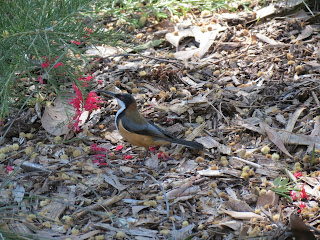Healesville surprisingly turned out to be the most productive site. The emu exhibit's feeders were attracting many galahs and common bronzewings, while Australian white ibis rested in trees overhead, a few satin bowerbirds hopped around in the undergrowth and a single yellow-faced honeyeater was extremely high up in a tall eucalypt. Finally, a eastern spinebill sipped nectar from some nearby flowers.
The area around the emu exhibit is a reliable site for common bronzewing
A nearby flowering plant was this eastern spinebill's lunch
Both male and female satin bowerbirds were in the trees at the beginning of the exhibit
The birds were similar until we got to the Spirits of the Sky Flight Arena (an area where there is a birds of prey show). While waiting for the show to start, I saw many birds in the trees on the edges of Badger Creek (which flows through the sanctuary). There were quite a few yellow-faced honeyeaters, some brown thornbills, an eastern yellow robin and a single lifer white-naped honeyeater that allowed only quick views and a barely decent photo before leaving.
The white-naped honeyeater flew in for a quick drink before leaving
In the arena itself there were many grey fantails in a nearby tree, as well as sulphur-crested cockatoos and galahs flying over. The show itself was really nice and I almost got hit in the shoulder by a wedge-tailed eagle!We walked along a few more trails, but saw more of the same: however some ponds held a few chestnut teals and Pacific black ducks, as well as 3 purple swamphens.
After going to Healesville we arrived at our accommodation. We did a walk through woodland to a bird hide overlooking a wetland, however the woodlands were fairly quiet (brown thornbills, eastern spinebills, superb fairy-wrens, noisy miners, Indian mynas, common starlings, Australian ravens, little ravens and a single pied currawong), though the hide was overlooking a large roost of about 30-40 eastern great egrets and greater cormorants. The walk also went past the Yarra River and there were Pacific black ducks, dusky moorhens, Eurasian coots and purple swamphens in the river. Finally a grassy lawn at the start of the walk held grazing Australian wood ducks, a single masked lapwing and some white-faced herons.
This grey currawong was rather shy for his species
For a site near Melbourne this is a very large number of eastern great egrets
The next morning we visited the Wirrawilla Rainforest Walk. This walk is roughly half-an-hour's drive from Healesville. The walk itself wasn't very productive, however there were many birds around the carpark and entrance: we saw grey fantails, brown thornbills, flame robins, white-browed scrubwrens and a golden whistler.
Both a male and female flame robin were at the carpark, the male is shown here
Finally, on the way back home we visited one of the area's many vineyards: though the vineyard was fully booked for lunch there were many goldfinches in the carpark, one of Victoria's less common introductions.
The goldfinch is one of several birds introduced by the European colonists of Australia
SPECIES SEEN:1. Pacific Black Duck
2. Chestnut Teal
3. Australian Wood Duck
4. White-Faced Heron
5. Eastern Great Egret
6. Greater Cormorant
7. Dusky Moorhen
8. Purple Swamphen
9. Eurasian Coot
10. Masked Lapwing
11. Spotted Dove
12. Common Bronzewing
13. Sulphur-Crested Cockatoo
14. Galah
15. Rainbow Lorikeet
16. Crimson Rosella
17. Superb Fairy-Wren
18. White-Browed Scrubwren
19. Brown Thornbill
20. Golden Whistler
21. Red Wattlebird
22. Eastern Spinebill
23. New Holland Honeyeater
24. White-Naped Honeyeater
25. Noisy Miner
26. Grey Fantail
27. Willie Wagtail
28. Australian Magpie
29. Pied Currawong
30. Little Raven
31. Australian Raven
32. Welcome Swallow
33. Blackbird
34. Indian Myna
35. Common Starling
36. Goldfinch
TOTAL: 36
LIFERS: 1











































